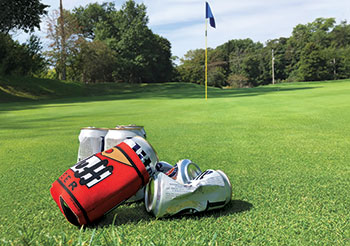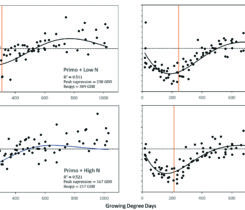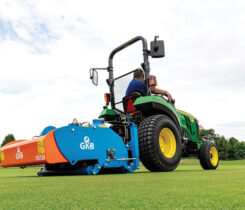Sober advice on collar decline

Photo: Seth Jones
Just as shirt collars tend to wear quickly, collars on greens also tend to decline fast.
At superintendent gatherings, explanations for collar decline are many: Irrigation runoff gets trapped there, they suffer extra abuse by mowers and other equipment, crews pile bags of fertilizer on the collars rather than dimple greens.
However, drawing on a decade of experience with collar decline, University of Nebraska turfgrass researcher William Kreuser, Ph.D., has another culprit in mind: PGRs.
“The big factor in collar decline is overapplication of PGRs,” Kreuser says. “The PGR effect on both collars and fairways is greater and lasts longer than it does on greens.”
He compares PGRs for grass to beers for golfers. A lightweight drinker can absorb a beer or two in an afternoon. A big guy is likely fine handling a six-pack over time. Drinking a case, for anyone, is overkill. Yet that’s what he sees happening on golf courses with PGRs.
Collars are heavy drinkers
“Collars are getting drunk on PGRs,” Kreuser explains. Because the effects of PGRs are cumulative, as is alcohol in humans, pretty soon these effects are devastating. “We overapply PGRs if we use them at the same rate as we do on greens.” The plants stagger and fail to grow. That leaves them more susceptible to low-growth diseases like dollar spot.
It shows up fast. “Bentgrass fairways and collars are much more sensitive to PGRs than greens are,” Kreuser states. The work has not yet been replicated on bluegrass, although there may be parallels.
The simple fact is the PGR effect is greater and lasts longer on collars than on greens. Greens are noticeably warmer than collars. They grow faster. The hormone that PGRs inhibit is produced faster in greens, and more PGR material is removed with daily greens mowing.
Toss out your calendar
In research at places as varied as New York, Arkansas and Nebraska, Kreuser has found that multiple factors may counteract drunken and damaged collars.
“Toss out your calendar,” Kreuser advises. “Use growing-degree day models.”
Almost any golf management website has a way to calculate local growing-degree day (GDD) data. GreenkeeperApp.com is a good one. At 350 GDDs, Primo will give 20-percent suppression on greens versus 55-percent suppression on fairways.
With Trimmit, a superintendent can stretch it even longer if conditions allow. Kreuser figures that 250 to 270 GDDs is a good target for most applications. Trimmit at 5.5 ounces will be effective. Legacy at 4.8 ounces at 270 GDDs or Musketeer at 12 ounces on 290-day schedules work.
Forget about doubling the rate and trying to extend the activity period. A two-times rate typically gives a mere two extra days of suppression.
Overapplication is a major concern in the spring when the weather is cool. The GDDs do not add up as quickly, Kreuser told a gathering of superintendents at the recent Ohio Turfgrass Foundation conference. Likewise, temperature dips in the summer can wreak havoc with PGR performance and collar survival.
“The biggest challenge with PGRs is to know when they are working,” Kreuser says. “I don’t care if it is 110 degrees … those PGRs are still working. When it is warm, all grasses grow fast. They’d grow even faster if you hadn’t applied PGRs.”
Fairways, too, are more sensitive than greens to PGR applications. Keep that in mind when figuring application rates and time intervals.
Research indicates that lowering the mowing height on collars might help, too. There is some serendipity in this finding, which appeared in Kreuser’s research accidentally.
“If you are mowing bentgrass or bent/Poa collars at one-half inch, going down to three-eighths or .350 would be one way to mitigate damage,” he says. Or, take a .400 height down to .300 on collars.
“Reducing mowing heights makes the grass grow faster.” Somewhat higher N rates will help, too.
You’ll know by the yield.
The only sure way to know when, and how well, a PGR is performing is to do regular clipping yield checks. Be aware of the PGR effect on greens speeds, too. On bentgrass, peak suppression generally happens around day seven. When it is hotter, courses have to be ready to apply Primo every week as opposed to three- or four-week intervals later in the season.
If you find yourself in trouble, he says, it might pay to look at a gibberellin product like RyzUp. Applied at 0.15 ounces per acre, it will give stunted collars a real boost.
Rather than continuing to overdose, look at regulating the N on the collars. Consider lowering mower height from .500 to one-quarter inch.
First aid for PGR-soaked greens is possible on leaf-absorbed materials. Simply hose or irrigate the collars a bit more, washing off excess material. This has to be done right away, because 90 percent of PGR material is absorbed within 15 minutes of spraying a product like Primo.
“Don’t let it sit,” Kreuser says. “You have to do it rapidly — within 10 minutes.” This strategy works only with foliar-absorbed PGRs and not products like Trimmit or Cutless or combinations.
Another strategy is to turn off the boom early when doing a PGR-only spray. Many programs alternate a tank mix spray of fertilizer, control products and PGRs with a PGR-only spray. It is tough to risk not getting full coverage, but keeping the PGRs away from the collar on the PGR-only spray is a good idea. GPS sprayers can be a big help.
“Over-regulation of collars is real,” Kreuser says. “Don’t get your collars drunk on PGRs.”
A frequent contributor to Golfdom, Curt Harler is a freelance writer with expertise in agronomy and turfgrass who resides in Strongsville, Ohio.













I for one hope they do not go away any time soon . I like what the bring to the course, as do most golfers.Remember going from the rough to the green (for the majority of golfers in the world) is one of the tougher shots in golf.Plus it looks very nice when maintained properly.Just one mans opinion.